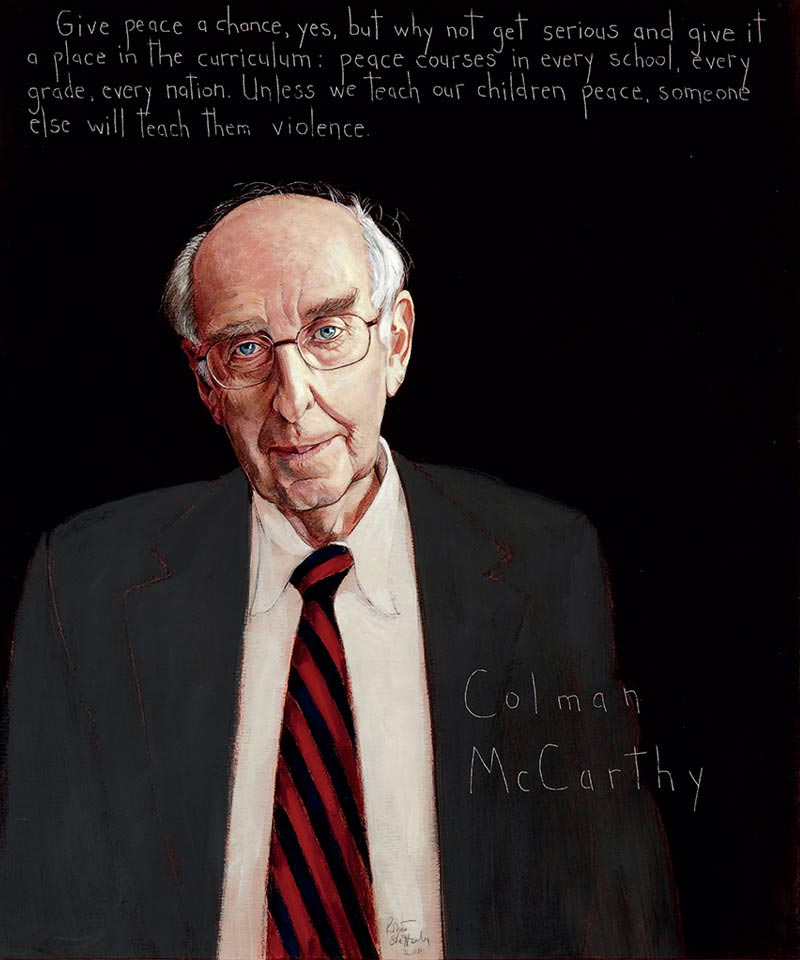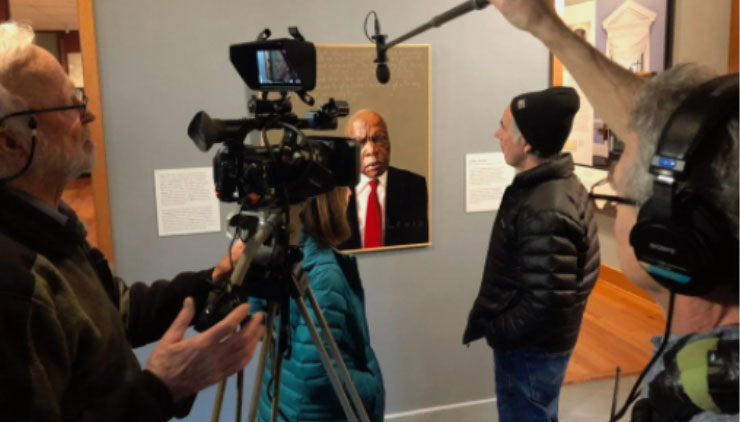
Colman McCarthy
Journalist, Developer of Peace Studies Curriculum : b. 1938
“Give peace a chance, yes, but why not get serious and give it a place in the curriculum: peace courses in every school, every grade, every nation. Unless we teach our children peace, someone else will teach them violence.”
Biography
When Colman McCarthy left The Washington Post in 1998, after nearly 30 years as a columnist, he had another fulltime job lined up—teaching Peace in America’s classrooms and lecture halls. He’d started teaching Peace part-time in 1982 and by 2011 had instructed more than 10,000 students in what he calls “the other side” of the story.
“I’ve been accused of teaching a one-sided course, that I don’t expose students to the other side,” he wrote in The Nation, “except that my course is the other side—the one that students aren’t getting in conventional history or political science courses that present violent militaristic solutions as rational and necessary.”
McCarthy says adding a single course on Peace to most any school’s curriculum is like “muscling” it in through “extraordinary flexing…
“I recall speaking at a New England prep school and being told by the headmaster that he takes peace education seriously: Once a year, Peace Day is observed. I wondered: Is there an annual Algebra Day? A yearly Physics Day?…Yes, children, let’s give peace a chance—but not a place in the curriculum,” writes McCarthy.
Despite that kind of resistance, peace education is growing. Back in 1970, there was a single college program in peace studies in the United States; by 2011, there were more than 500.
But that’s not enough for McCarthy. When he addresses a new audience, McCarthy likes to ask how many present have taken a peace course. Few, if any, hands go up. “If this were a peace-loving, peace-seeking and peace-building society, every hand would have gone up. We all graduate as peace illiterates,” he says.
Born in Glen Head, New York, in 1938, McCarthy graduated from the Jesuit-affiliated Spring Hill College in Mobile, Alabama and spent five years in a Trappist monastery. When he began his career in journalism, he decided to be a peace correspondent instead of a war correspondent. “I decided we have enough people doing that,” he told KPBS radio in 2010, “so I thought I would write about people who were offering solutions to the world’s violence.” He began by covering Martin Luther King Jr. in the summer of 1966.
He went on to interview many prominent peace activists, including Nobel Peace Prize winners Archbishop Desmond Tutu, Mother Teresa, Ireland’s Mairead Corrigan and Sean McBride, Argentina’s Perez Esquivel and Muhammad Yunus of Bangladesh.
“I’d always ask them how should we go about increasing peace and decreasing violence,” says McCarthy, adding that the answer was almost always the same: Go where the people are. “And where are the people? Well, they’re in our schools.”
His first foray into the classroom was at School Without Walls, a public high school in Washington, DC. He established a motto for the class: “Instead of asking questions, be bolder and question the answers.” The most important “answer” to question is the idea that violence leads to peace. “If violence were truly effective,” says McCarthy, “we would have had peace eons ago.”
Instead of the “necessity” of war, McCarthy talks about the victories of peace: “Now if someone came to you 20, 25 years ago and said, I think that in the next two and half decades there’ll be at least seven brutal governments overthrown by people that have no army, no bombs and no bullets, you’d have said, friend, you’re clearly dreaming. But it happened…Marcos in the Philippines, Pinochet in Chile, Lech Walesa’s efforts in Poland, Nelson Mandela in South Africa, Milosevic in Yugoslavia, Shevardnadze in Georgia, Vaclav Havel becoming president in Czechoslavakia…And so there’s proof that, as Martin Luther King said, if nonviolent resistance is well organized, it can be far more effective than violence.”
McCarthy’s convinced the best place to take that message is to the classroom. “This country has 4,500 colleges and universities. We have about 36,000 high schools and about 78,000 elementary schools. That’s where the peace movement needs to be. Marches are fine, protests are fine,” he says, “but it’s in schools where things really happen.”
McCarthy married Mavorneen Deegan, a nurse, in 1966. They have three sons and live in Washington DC. Together they founded The Center for Teaching Peace in 1985. McCarthy’s books include I’d Rather Teach Peace and All of One Peace.
The Center for Teaching Peace curriculum includes writings by Gandhi, Tolstoy, Robert Coles, Dorothy Day, Barbara Deming, Gene Sharp, Joan Baez, Howard Zinn, Daniel Berrigan, Alice Walker, Martin Luther King Jr., Sargent and Eunice Shriver, Jonathan Schell, Scott and Helen Nearing, Wangari Maathi, and many others.
McCarthy lectures widely and has taught Peace at Bethesda-Chevy High School in suburban Washington, Wilson High in the District of Columbia, Georgetown University Law Center, American University, the University of Maryland, and the Washington Center for Internships, among other places.
He was awarded an Alicia Patterson Journalism Fellowship in 1998, and is a recipient of the Peace Abbey Courage of Conscience Award.
McCarthy, a vegan, is also an animal rights advocate. His primary mode of transportation is a bicycle, on which he has passed the 100,000-mile mark.
Programs
Americans Who Tell the Truth (AWTT) offers a variety of ways to engage with its portraits and portrait subjects. Host an exhibit, use our free lesson plans and educational programs, or engage with a member of the AWTT team or portrait subjects.

Education
AWTT has educational materials and lesson plans that ask students to grapple with truth, justice, and freedom.

Exhibits & Community Engagement
AWTT encourages community engagement programs and exhibits accompanied by public events that stimulate dialogue around citizenship, education, and activism.